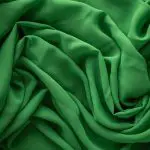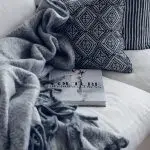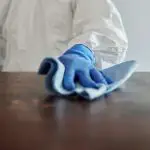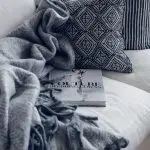So, you've got a cozy couch that's seen better days. Picture this: You're wondering, 'Can you Lysol a couch?' and how to keep your fabrics clean without damaging them. In this guide, you'll learn safe and effective methods for cleaning various fabric types.
We'll cover Lysol safety guidelines, spot cleaning techniques, DIY fabric disinfectants, and professional upholstery cleaning options. Whether it's a stubborn stain or a routine freshening up, mastering fabric care will keep your couch looking its best.
Stick with us, and you'll gain the confidence to tackle any fabric cleaning challenge. Let's dive in and elevate your fabric cleaning game!
Key Takeaways
- Different fabrics require different cleaning methods and care.
- Lysol disinfectant spray can be used on fabrics labeled as bleach cleanable or colorfast, but it's important to test in an inconspicuous area or consult the manufacturer's cleaning instructions for delicate or non-colorfast fabrics.
- Spot cleaning techniques involve blotting the stain, applying a fabric-friendly stain remover, and gently dabbing the stained area to prevent spreading.
- DIY fabric disinfectants such as vinegar solution, essential oils spray, and hydrogen peroxide solution can be used as natural alternatives to commercial products, but it's important to spot test them before applying widely.
Understanding Fabric Types
When cleaning fabric on your couch, it's essential to understand the different types of fabrics to ensure you use the appropriate cleaning methods. Different fabrics, such as cotton versus polyester, require different care.
Cotton is durable and can withstand high temperatures, making it easier to clean. On the other hand, polyester is less prone to wrinkles and shrinking, but it's sensitive to heat. Understanding these differences will help you tailor your cleaning approach.
Moving on to silk versus wool, it's crucial to note that silk is a delicate fabric that requires gentle care. It's best to avoid using strong chemicals or excessive agitation when cleaning silk. Wool, while durable, is prone to shrinking if not handled properly. Therefore, it's important to follow specific cleaning instructions to prevent damage.
Stain removal is another critical aspect of fabric care. Different stains require different treatment methods, and using the wrong approach can worsen the situation. It's essential to identify the stain and use the appropriate cleaning agents to effectively remove it without damaging the fabric.
Understanding fabric types is fundamental in ensuring that your cleaning efforts are both effective and safe for your couch.
Lysol Safety Guidelines
To ensure the safe and effective use of Lysol on your couch, it's important to follow specific safety guidelines tailored to different fabric types. When it comes to disinfectant application, it's crucial to consider fabric compatibility to prevent any damage.
For fabrics labeled as bleach cleanable or colorfast, you can use Lysol disinfectant spray. However, for delicate or non-colorfast fabrics, it's recommended to test an inconspicuous area first or consult the manufacturer's cleaning instructions to ensure Lysol won't cause discoloration or damage.
When applying Lysol, always follow the directions on the product label. Ensure proper ventilation in the area and avoid over-saturating the fabric. After disinfectant application, allow the fabric to air dry completely before using the couch again.
It's important to note that while Lysol is effective in killing germs, viruses, and bacteria, it's essential to use it safely, especially on fabrics. By adhering to these safety guidelines, you can effectively disinfect your couch without compromising its quality.
Spot Cleaning Techniques
You can effectively spot-clean your couch using a fabric-friendly stain remover. When it comes to fabric maintenance and stain removal, it's essential to have the right tools.
Look for eco-friendly cleaning products or consider making your own homemade solutions for spot cleaning. These options aren't only gentle on your couch but also better for the environment.
For fabric-friendly stain removal, start by blotting the stained area with a clean cloth to absorb any excess liquid. Then, apply the fabric-friendly stain remover according to the manufacturer's instructions. Gently dab the stained area with a clean cloth, working from the outside in to prevent spreading the stain. Avoid rubbing the fabric vigorously, as this can damage the fibers.
After treating the spot, allow it to air dry thoroughly. If you're dealing with a particularly stubborn stain, consider repeating the spot-cleaning process or seeking professional help.
DIY Fabric Disinfectants
After effectively spot-cleaning your couch, it's important to consider DIY fabric disinfectants to ensure a thorough and safe cleaning process. When it comes to homemade disinfectants for fabric, there are several natural fabric cleaners you can easily make at home. Here are a few options to consider:
- Vinegar Solution: Create a solution using equal parts water and white vinegar. Vinegar has natural disinfectant properties and can help eliminate bacteria and odors from your fabric upholstery.
- Essential Oils Spray: Mix water with a few drops of essential oils such as tea tree, lavender, or eucalyptus. These oils have antimicrobial properties and can be used as a fabric disinfectant.
- Hydrogen Peroxide Solution: For tougher stains and disinfecting needs, you can dilute hydrogen peroxide with water. This solution can help to disinfect and brighten fabrics without causing damage.
These homemade disinfectants are effective and safe for most fabric types, but it's always a good idea to spot test in an inconspicuous area before applying them widely. Remember, natural fabric cleaners can be a great alternative to commercial products, especially if you prefer using non-toxic cleaning solutions.
Professional Upholstery Cleaning
Consider hiring a professional upholstery cleaning service for a thorough and effective fabric maintenance. When it comes to maintaining the integrity and cleanliness of your furniture, professional cleaning services can offer expert solutions that go beyond what you can achieve with DIY methods. Here's a breakdown of some common fabric maintenance and cleaning techniques used by professional upholstery cleaners:
| Fabric Maintenance | Cleaning Techniques |
|---|---|
| Vacuuming | Hot Water Extraction |
| Stain Removal | Dry Cleaning |
| Fabric Protection | Steam Cleaning |
| Odor Elimination | Low-Moisture Cleaning |
| Fiber Inspection | Spot Cleaning |
These techniques are often executed by professionals equipped with specialized tools and products to ensure a deep and thorough clean while also preserving the fabric's quality. Professional upholstery cleaning can effectively remove deeply embedded dirt, odors, and stains, ultimately prolonging the life of your furniture. Keep in mind that regular professional maintenance can also contribute to a healthier indoor environment for you and your family.
Preventive Fabric Care Tips
To effectively maintain your fabric's cleanliness and integrity, regularly implement simple preventive care tips. Proper fabric protection and stain removal techniques can go a long way in preserving the look and feel of your upholstery. Here are some preventive fabric care tips to keep your fabrics looking fresh and clean:
- Vacuum regularly: Dust, dirt, and debris can settle into the fibers of your fabric, leading to discoloration and deterioration over time. By vacuuming your upholstery on a regular basis, you can prevent these particles from embedding themselves into the fabric.
- Rotate cushions: To ensure even wear and tear on your upholstery, it's important to rotate and flip the cushions regularly. This simple step can help prevent one side of the fabric from becoming more worn than the other.
- Use fabric protectors: Applying a fabric protector can help repel stains and spills, making it easier to clean up any accidents before they've a chance to set in.
Conclusion and Additional Resources
To wrap up our discussion on preventive fabric care tips and transitioning into additional resources, let's delve into effective cleaning methods and where to find reliable information for maintaining your upholstery.
When it comes to disinfectant alternatives for your couch or other upholstered furniture, it's essential to choose products that are safe for the specific fabric. Always check the manufacturer's recommendations and labels to ensure you're using the appropriate cleaning solutions.
Additionally, proper fabric care involves regular vacuuming, spot cleaning, and addressing spills promptly to prevent staining and bacterial growth.
For those seeking further guidance on maintaining the cleanliness and longevity of their upholstery, reliable information can be found in upholstery care guides from reputable furniture manufacturers, professional cleaning service websites, and industry-specific publications. These resources offer valuable insights into the best cleaning practices, suitable products, and specialized treatments for different types of fabric.
Frequently Asked Questions
Can Lysol Be Used on Leather or Suede Couches?
You can use Lysol on leather or suede couches, but it's essential to spot-test first. For delicate fabrics like silk or velvet, consider using a gentle fabric-specific cleaner. Always follow the manufacturer's recommendations for cleaning.
Is It Safe to Use Lysol on Delicate Fabrics Like Silk or Velvet?
When cleaning delicate fabrics like silk or velvet upholstery, it's important to consider Lysol safety. Opt for pet-friendly cleaning products, and always test a small, inconspicuous area first to ensure it won't damage the fabric.
Can Lysol Cause Discoloration or Damage to Certain Types of Upholstery?
Using Lysol on upholstery can pose discoloration risks and potential damage to certain types of fabrics. It's essential to carefully consider upholstery care and Lysol safety to avoid any unwanted consequences.
What Are the Potential Health Risks of Using Lysol on Furniture That Is Frequently Used by Pets or Small Children?
When using Lysol on furniture frequently used by pets or small children, potential risks include skin and respiratory irritation. Safe alternatives like mild soap and water or upholstery cleaners can effectively clean without the health concerns.
Can Lysol Effectively Remove Pet Odors and Stains From Couches and Other Upholstery?
You can use natural alternatives for removing pet odors and stains from upholstery. If needed, consider professional cleaning services for a thorough solution. It's essential to ensure a safe and effective cleaning process for your furniture.
- Is Chiffon Fabric Itchy? - April 23, 2024
- Are There Different Types of Chiffon Fabric? - April 23, 2024
- Can You Paint Chiffon Fabric? - April 23, 2024








